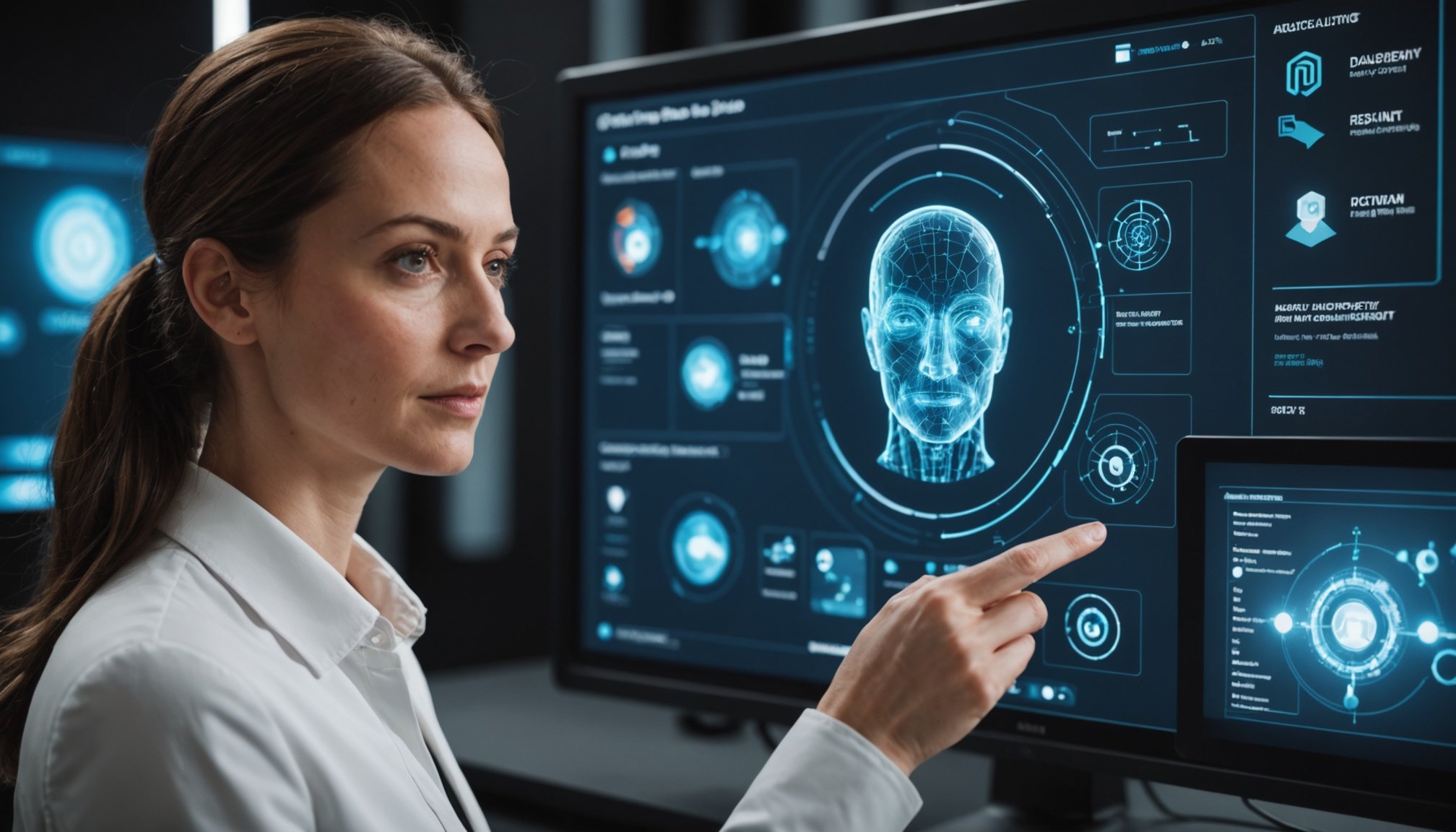Overview of Biometric Authentication
Biometric authentication is a security process that verifies an individual’s identity using their unique biological characteristics. This technique has become increasingly important in digital security, offering a more secure alternative to traditional methods like passwords. Common biometric modalities include fingerprint scanning, facial recognition, and iris recognition. Each provides a layer of security based on physical traits that are difficult to fake or replicate.
In recent years, the integration of AI has brought significant advancements to these systems. AI integration enhances the accuracy and speed of biometric authentication, making it more reliable and efficient. For instance, facial recognition systems now employ AI algorithms to analyze and match facial features in real-time, even in less-than-ideal conditions. AI also enables these systems to learn and improve over time, adapting to changes in the user’s appearance or environment.
Also to discover : Unlocking Retail Success: Leveraging AI for Smart Predictive Analytics in Inventory Management
The system overview of biometric authentication typically involves capturing a biological trait, converting it into a digital template, and comparing it against stored data for verification. AI plays a crucial role here, not only in data analysis but also in identifying patterns and anomalies that might indicate fraud. By offering a seamless and secure solution, biometric authentication is increasingly being adopted across various sectors, from smartphones to high-security facilities.
AI Technologies Enhancing Biometric Authentication
Advancements in artificial intelligence and machine learning are revolutionising biometric authentication. One critical aspect is the implementation of machine learning algorithms in biometric systems. These algorithms improve the accuracy of recognising individual features by learning from vast datasets. As these systems encounter more data, they become better at distinguishing between subtle differences in user patterns, such as fingerprints and facial features.
This might interest you : Top Strategies for Successfully Integrating AI into Environmental Monitoring Systems
Incorporating sophisticated image processing techniques has boosted recognition rates substantially. By analysing visual data with greater precision, these technologies ensure the system can accurately identify individuals even in challenging conditions, such as varied lighting or partial obstructions. Enhanced image processing further mitigates errors caused by poor quality inputs, making biometric systems more reliable.
Another innovation is the use of adaptive learning mechanisms, which adjust to new data in real-time. This capability offers significant benefits for maintaining accuracy and efficiency, even as user appearances change or external conditions vary. As security requirements continue to evolve, adaptive systems are better equipped to maintain stringent accuracy standards without requiring complete system overhauls.
Employing AI in biometric authentication represents a leap forward in security and ease of use, harnessing the power of technology advancements for more robust and trustworthy identification processes.
Case Studies: Successful AI Integration in Biometrics
Exploring real-world applications of AI in biometrics can illuminate the biometric system success story. Such insights pave the way for understanding how these technologies enhance security and efficiency.
Case Study 1: Facial Recognition in Airports
Airports worldwide have embraced AI-driven facial recognition systems to bolster security and streamline passenger processing. By comparing passenger photos against a database, these systems enhance accuracy, increasing security metrics significantly. For instance, after AI implementation, airports have reported precision rates of up to 99.7% when matching faces to photographic IDs. This advancement not only reduces check-in times but also elevates user acceptance due to its efficiency and non-intrusive nature.
Case Study 2: Fingerprint Scanning in Mobile Devices
The integration of fingerprint scanning technology in mobile devices represents another biometric system success. AI algorithms adapt to minor changes in users’ fingerprints, maintaining precision. Statistical gains show a significant reduction in false rejections. Feedback demonstrates high user acceptance, with many appreciating the balance of convenience and security, encouraging broader adoption.
Case Study 3: Iris Recognition in Healthcare
Healthcare systems benefit from AI case studies like iris recognition technology, enhancing patient identification precision. Reports indicate accuracy improvements exceeding previous methods by 30%. This high level of accuracy ensures that patient records are correctly accessed, enhancing security metrics. Users generally respond positively, valuing the increased accuracy and reduced room for error in patient care processes.
Benefits of AI in Biometric Authentication
Implementing AI in biometric authentication offers notable advantages, significantly enhancing security and user experience. One of the key benefits of AI is its ability to increase accuracy by reducing false positives and negatives. Accurate authentication is crucial as it ensures that legitimate users are granted access while preventing unauthorized entry.
AI-driven systems continuously learn and adapt, making them adept at recognising subtle differences in biometric data. This adaptability is particularly beneficial in combating spoofing and fraud attempts. By enhancing security measures, AI systems can detect anomalies and predict potential threats with greater precision, ensuring a robust defence against malicious activities.
Moreover, incorporating AI in biometric processes vastly improves the user experience by reducing processing times. Traditional authentication methods can often be slow and cumbersome, leading to user frustration. In contrast, AI ensures seamless and efficient processing, allowing users to access secure systems quickly and easily.
From increased accuracy to the seamless experience it facilitates, the integration of advanced AI technologies in biometric authentication offers a perfect balance between security and convenience. As AI continues to evolve, we can anticipate even more refined solutions, further solidifying its role as an indispensable component in the realm of security.
Challenges and Limitations of AI-Enhanced Biometric Systems
Biometric systems augmented by AI bring numerous advancements, but challenges remain prevalent. Privacy concerns are paramount, as biometric data—comprising unique personal identifiers—requires stringent protection. Breaches could lead to severe security risks, if unauthorized entities access sensitive information.
Amidst these concerns, technical limitations persist, notably in varied environmental conditions. For instance, fingerprint scanners may falter in humid conditions or when users have damp hands, reducing their reliability. Similarly, facial recognition systems may struggle with different lighting conditions or obstructed views.
Moreover, the potential for bias in AI algorithms poses a significant challenge. If training datasets are not diverse, AI can inadvertently favour certain demographics, affecting accuracy and equality. This concern extends beyond societal consequences, as businesses relying on such algorithms could face security risks, including false positives or negatives during identity verification processes.
These challenges underline the necessity for robust systems, improved biometric limitations, and ethical AI practices. Encouragingly, ongoing research seeks to refine algorithms, enhance dataset diversity, and strengthen data security protocols to mitigate these limitations. By understanding these issues thoroughly, stakeholders can better address them, ensuring advanced biometric systems maintain their promise of a secure and fair technological future.
Future Trends in AI and Biometric Authentication
The future of biometrics promises exciting advancements, especially as emerging technologies continue to evolve. One notable trend is the development of multi-modal biometric systems, combining multiple biometric indicators such as fingerprints, facial recognition, and voice analysis. This integration enhances accuracy and security, offering a more robust authentication process that adapts to a variety of scenarios.
As these systems advance, we anticipate significant changes driven by rapid AI trends. AI enhances the ability to analyze vast datasets, improving the predictive accuracy of biometric systems. Algorithms are becoming more sophisticated, allowing for faster and more precise identification, even in complex environments.
However, this progress isn’t just technological. The future of biometrics also hinges on the evolving landscape of regulatory standards and user acceptance. Policymakers are tasked with ensuring these technologies are used ethically, balancing innovation with privacy concerns. Consumers, meanwhile, must be assured of the security of their data to fully embrace these advancements.
In summary, the intertwining of AI and biometrics signifies a transformative period. Multi-modal systems, AI enhancements, and regulatory developments collectively shape the landscape, promising a future where secure, efficient authentication is the norm.










